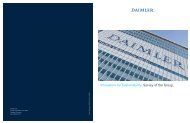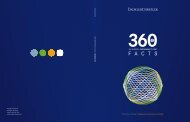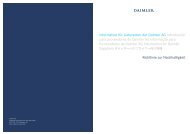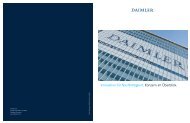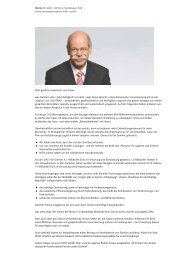Dear readers, This report describes what Daimler means by ...
Dear readers, This report describes what Daimler means by ...
Dear readers, This report describes what Daimler means by ...
Create successful ePaper yourself
Turn your PDF publications into a flip-book with our unique Google optimized e-Paper software.
<strong>Daimler</strong> 360 GRAD - FAKTEN zur Nachhaltigkeit 2008<br />
<strong>Daimler</strong> Nachhaltigkeitsbericht 2008 / Environmental protection, innovation, and safety / Innovation, development and safety /<br />
Sustainable mobility strategy for commercial vehicles<br />
� Resolute further development and optimization of our internal combustion engines. Experts are certain that<br />
diesel engines will remain the backbone of heavy-duty commercial vehicle drive systems for decades to<br />
come. <strong>This</strong> certainty stems from the fact that a comprehensive global infrastructure for diesel fuel and diesel<br />
engine production and servicing already exists – not to mention the great reliability and unsurpassed<br />
economy that diesel engines offer. The BLUETEC technology that has been available in our commercial<br />
vehicles since January 2005 saves between 1,500 and 2,000 liters of diesel fuel in long-distance truck<br />
operation per vehicle and year, as compared to other exhaust-gas treatment systems. <strong>This</strong> <strong>means</strong> that trucks<br />
equipped with BLUETEC, which currently number about 150,000, save approximately 300 million liters of fuel<br />
per year. Further fuel economy improvements can also be achieved <strong>by</strong> optimizing transmissions and<br />
powertrains. For example, the current generation of Mercedes PowerShift automated transmissions in<br />
Mercedes-Benz trucks leads to very low levels of fuel consumption.<br />
Natural gas is a good alternative to diesel drive systems in urban applications. The Mercedes-Benz Citaro<br />
CNG (compressed natural gas) is built as both a single and an articulated bus with a natural gas engine; there<br />
are currently around 900 such busses in use. The Citaro CNG was the first urban bus with a natural gas drive<br />
to comply with the strict EEV (Enhanced Environmentally Friendly Vehicle) emissions standard. Today there<br />
are 600 Mercedes-Benz Econic NGT models throughout Europe that are used for garbage collection and<br />
other municipal applications, and also serve as delivery vehicles. Like the Citaro CNG, the Econic NGT has<br />
lower emissions than those required <strong>by</strong> the Euro V or EEV standards, and also stands out through its low<br />
noise emissions. The use of natural gas vehicles does remain limited, however, <strong>by</strong> the complexity involved in<br />
storing their fuel in heavy pressurized tanks, as well as <strong>by</strong> the lack of a fuel infrastructure.<br />
� Hybrid vehicles. Hybrid drive systems display their superior fuel efficiency most clearly in everyday use in city<br />
traffic. Urban buses with hybrid drives are more environmentally friendly, and if they are equipped with a<br />
storage battery they even operate emissionfree over short stretches. Hybrid drive systems can also reduce<br />
the fuel consumption of light trucks for short-range distribution and heavy-duty long-distance trucks,<br />
depending on the topography involved. For the future, <strong>Daimler</strong> is also considering testing hybrid operation in<br />
long-houlage trucks and touring buses.<br />
� Emission-free drives on the basis of the fuell cell and purely electrical drives. A major test of 36 Mercedes-<br />
Benz Citaro fuel cell buses in ten European cities, as well as in Beijing (China) and Perth (Australia), has<br />
demonstrated that fuel cell drives function reliably under a broad range of practical conditions. In the next<br />
stage of development, the Citaro G BlueTec Hybrid model will serve as the basis for a Citaro fuel cell hybrid<br />
bus.<br />
Drive technologies from <strong>Daimler</strong><br />
Percentage share Vehicles with<br />
gasoline engine<br />
Vehicles with<br />
diesel engine<br />
Europe1 31.4 68.5 X X<br />
NAFTA 61.2 38.9 X X<br />
Japan 44.6 55.4 X X<br />
1 Approximately 0.4 percent of the vehicles with gasoline engines manufactured for Europe were manufactured as natural gas variants.<br />
2 0.05 percent of the vehicles sold worldwide were equipped with hybrid drive systems.<br />
3 <strong>Daimler</strong> operates the largest fuel cell vehicle fleet (cars, vans, and buses) of all manufacturers worldwide.<br />
Vehicles with<br />
hybrid drive 2<br />
Vehicles with<br />
fuel cell drive 3



